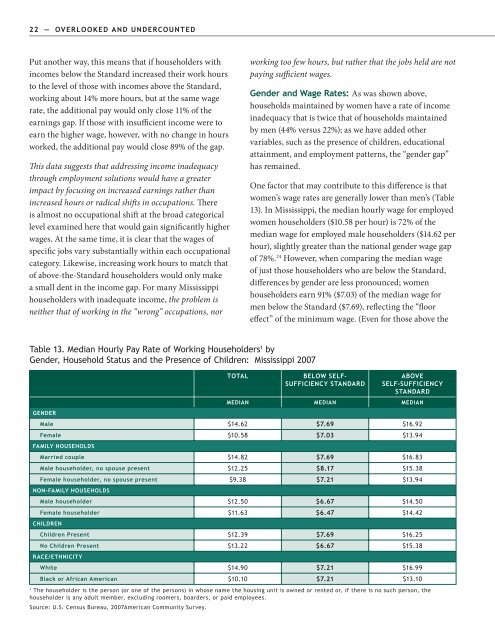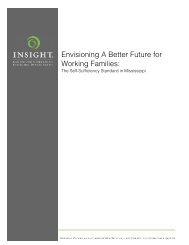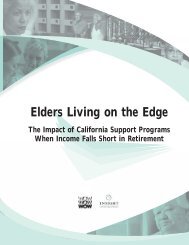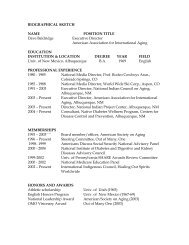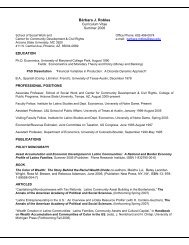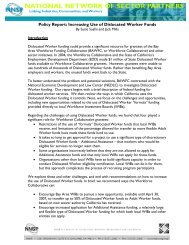Overlooked and Undercounted - Insight Center for Community ...
Overlooked and Undercounted - Insight Center for Community ...
Overlooked and Undercounted - Insight Center for Community ...
Create successful ePaper yourself
Turn your PDF publications into a flip-book with our unique Google optimized e-Paper software.
22 — OVERLOOKED AND UNDERCOUNTED<br />
Put another way, this means that if householders with<br />
incomes below the St<strong>and</strong>ard increased their work hours<br />
to the level of those with incomes above the St<strong>and</strong>ard,<br />
working about 14% more hours, but at the same wage<br />
rate, the additional pay would only close 11% of the<br />
earnings gap. If those with insufficient income were to<br />
earn the higher wage, however, with no change in hours<br />
worked, the additional pay would close 89% of the gap.<br />
This data suggests that addressing income inadequacy<br />
through employment solutions would have a greater<br />
impact by focusing on increased earnings rather than<br />
increased hours or radical shifts in occupations. There<br />
is almost no occupational shift at the broad categorical<br />
level examined here that would gain significantly higher<br />
wages. At the same time, it is clear that the wages of<br />
specific jobs vary substantially within each occupational<br />
category. Likewise, increasing work hours to match that<br />
of above-the-St<strong>and</strong>ard householders would only make<br />
a small dent in the income gap. For many Mississippi<br />
householders with inadequate income, the problem is<br />
neither that of working in the “wrong” occupations, nor<br />
working too few hours, but rather that the jobs held are not<br />
paying sufficient wages.<br />
Gender <strong>and</strong> Wage Rates: As was shown above,<br />
households maintained by women have a rate of income<br />
inadequacy that is twice that of households maintained<br />
by men (44% versus 22%); as we have added other<br />
variables, such as the presence of children, educational<br />
attainment, <strong>and</strong> employment patterns, the “gender gap”<br />
has remained.<br />
One factor that may contribute to this difference is that<br />
women’s wage rates are generally lower than men’s (Table<br />
13). In Mississippi, the median hourly wage <strong>for</strong> employed<br />
women householders ($10.58 per hour) is 72% of the<br />
median wage <strong>for</strong> employed male householders ($14.62 per<br />
hour), slightly greater than the national gender wage gap<br />
of 78%. 24 However, when comparing the median wage<br />
of just those householders who are below the St<strong>and</strong>ard,<br />
differences by gender are less pronounced; women<br />
householders earn 91% ($7.03) of the median wage <strong>for</strong><br />
men below the St<strong>and</strong>ard ($7.69), reflecting the “floor<br />
effect” of the minimum wage. (Even <strong>for</strong> those above the<br />
Table 13. Median Hourly Pay Rate of Working Householders 1 by<br />
Gender, Household Status <strong>and</strong> the Presence of Children: Mississippi 2007<br />
TOTAL<br />
BELOW SELF-<br />
SUFFICIENCY STANDARD<br />
ABOVE<br />
SELF-SUFFICIENCY<br />
STANDARD<br />
MEDIAN MEDIAN MEDIAN<br />
GENDER<br />
Male $14.62 $7.69 $16.92<br />
Female $10.58 $7.03 $13.94<br />
FAMILY HOUSEHOLDS<br />
Married couple $14.82 $7.69 $16.83<br />
Male householder, no spouse present $12.25 $8.17 $15.38<br />
Female householder, no spouse present $9.38 $7.21 $13.94<br />
NON-FAMILY HOUSEHOLDS<br />
Male householder $12.50 $6.67 $14.50<br />
Female householder $11.63 $6.47 $14.42<br />
CHILDREN<br />
Children Present $12.39 $7.69 $16.25<br />
No Children Present $13.22 $6.67 $15.38<br />
RACE/ETHNICITY<br />
White $14.90 $7.21 $16.99<br />
Black or African American $10.10 $7.21 $13.10<br />
1<br />
The householder is the person (or one of the persons) in whose name the housing unit is owned or rented or, if there is no such person, the<br />
householder is any adult member, excluding roomers, boarders, or paid employees.<br />
Source: U.S. Census Bureau, 2007American <strong>Community</strong> Survey.


